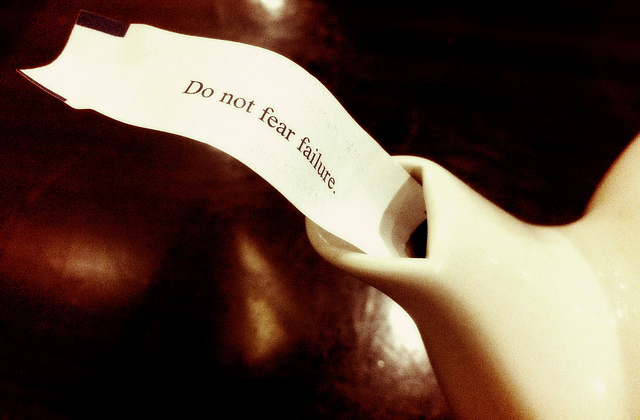I went into private practice as a psychotherapist over ten years ago, but I only got serious about making it financially successful recently.
I already felt confident about the quality of my work, but I hadn’t yet embraced the fact that I was running a business—which is shorthand for saying that I didn’t make much money and had almost no idea how to help new people find my work.
Fortunately, I was blessed with a messy divorce, two children and plenty of bills.
I had two choices: get a relatively low-paying, high-burnout job with long hours and little future; or, put all of my eggs in one basket and create a profitable business.
I have always been an all-your-eggs-in-one-basket kind of girl, so I decided to call upon exactly what graduate school had prepared me to do—wing it at the last minute on a deadline.
What I have learned is that going into business for yourself, especially when you essentially are your business, is not for the faint of heart. There are three components that make or break whether you will be successful at it, and most have nothing to do with your competence.
Number One: Be pretty darn good at what you do, and know it.
No one can really tell you if you are skilled enough in your field of expertise to go into business for yourself or not. So, that’s hurdle number one: You have to have both the skills and the confidence to know that you can do this.
Of the two, confidence is actually more critical than skill. This becomes clear when we think of all the successful entrepreneurs out there doing sub-par work.
To take step one, you actually have to be willing to step into a role of leadership. You may not consider yourself a leader quite yet, but you have to be ready to become one—and that takes separating your identity from your work.
Almost all of us want to be accepted, but being accepted when you are in business for yourself looks different. Being accepted no longer means that everyone likes you; rather, it is measured by people hiring you, referring to you, praising you and paying you. In the beginning, you aren’t likely to have a flood of people doing that, so you have to be able to access that place inside yourself and make an honest appraisal of your own work.
Here is an example: When I was in my twenties, I made my first and only base-jump. I was already a skydiving instructor and knew myself to be heads-up in dangerous situations, as well as to have very good accuracy on landing—both are imperative for the short and fast trip of a base jump. Still, jumping off a low, fixed object was entirely different than exiting a plane, and I was terrified.
I stood at the edge of the bridge for almost an hour before something occurred to me: I was, in my own opinion, as prepared as anyone could be to do their first base jump. I also realized that there is always going to be a “first time” whenever I do something new. So, I jumped off the 850-foot bridge and, about a minute and a half later, landed elegantly on the small sand bar below.
The analogy is not far-fetched. In my case, I was literally risking my life; in business, we literally risk our financial wellbeing, our image and our sense of self. We experience those risks as a survival-level decision, and for good reason.
Having the expertise and confidence to launch into our own business, replete with the financial realities it carries, is a step that weeds out perhaps 90 percent of the people who would otherwise start their own heart-centered or healing businesses. On the other hand, it also paves the way for people whose work is marginal but have the confidence to put their work out anyway. I watched plenty of people base-jump whose skills were not as good as mine, and most of them did just fine.
To make your business fly, you need to have both expertise and confidence. But, while you can continue to grow in your craft, the confidence part is non-negotiable. If you lack confidence, it doesn’t matter how good your work is, because without it, you never get off the bridge.
Number Two: Get some practical know-how in structuring and running a business.
Sorry, but you do actually need a layperson’s equivalent of an MBA, after all. The good news is that this is the easy part.
Almost every training or group out there focuses on this point, and it’s because there is truth in it. This information won’t, in and of itself, make your business successful. But, once again, without this know-how your business is very likely to fail.
We are talking about the nuts and bolts.
Do you have a website? If not, how do you build one? Is your mailing list set up? Do you have on-line scheduling? What is your branding? Is it compelling and crystal clear? Can people find you? How do you reach out to new people? Do you have videos and trainings available? Can you do online and in-person seminars? How do you package them into information products that you can offer later? How do you become the number one person that people say, “Oh, you need that? You should meet… (insert your name here)”?
None of these steps is rocket science, but there is a fair amount to learn.
My daughter once asked me if learning to drive is hard. My answer was an unequivocal “no,” but then I had to reconsider. I realized that, although there is no one part of driving that is difficult, when you put it all together—especially in rush hour or a snow storm—well, yes, it is difficult, especially in the beginning.
Creating your business is like that. Each step is almost ridiculously easy to learn, but put it all together—the amount of new things you have to learn, implement, fit together, hold boundaries as a business person (when maybe all you want is to serve people)—it’s challenging. And, once again, like driving, the stakes are for real.
The first trick is to start looking at your business the way others will see your business. Although you are offering your unique gifts, this is really about your client’s needs. Paradoxically, you can offer more when you create an honest and informative image of yourself and your work (branding) so that your clients have a clear, comfortable and informed way to enter your front door.
The second trick is to watch and model other businesses that you see are doing well and that you appreciate. There are a lot of people who have successfully jumped off the bridge, so which ones do you want to emulate?
For me, some seem insincere or even sleazy, and although they may seem confident and successful, I find that I don’t actually trust their work. These people are the anti-role-models, and they teach me a lot about what I don’t want to do.
I have also found people who I would like to emulate. They strike a beautiful balance, in my opinion, of authenticity and also of being on the cutting edge. I feel a sense of trust in the whole way that they put themselves out there. The trick here is to find the ones who inspire you and follow them. Get on their newsletters. Watch and mimic how they reach out to people.
The third trick is to invest your time and money only in what will give you both: the nuts and bolts of how to build and structure your business, and someone you admire as a mentor.
There is a ton of information out there, and much of it is free. Sign up for everything that doesn’t insult your soul and start watching, listening and learning. When you find something worth your time and dollars, hire a coach or join a coaching program to educate and support you to take your business into its new frontier.
This is business, not self-help (although maturing personally is certainly a by-product). Look at it as an investment and take a hard look at your anticipated return. I invested about $9,000 into a personal coach and then a business coaching Mastermind and it almost tripled my business and my confidence level.
That is far more cost-effective than an MBA.
Number Three (and by far the most important): Get to the root of what stops you from doing what you know you need to do next.
Going into business for yourself, especially if your livelihood depends on it, will make you face every edge and every fear. You will sail through some things and other things will stop you in your tracks. You need a way to work with the ones that stop you.
When you work for yourself you become the Visionary, the Strategist, the IT person, Developer of Curriculum, Motivator, Teacher, Counselor, Speaker, Leader, Healer, Marketer, Designer, Administrator, Supervisor and Financial Backer. One or more of these roles is a stopping place for most people.
Everyone has an Achilles’ heel in some of these areas, often on a daily basis. It’s what stops you and takes you down. If you don’t identify your particular obstacles and find a powerful way to transform them you won’t continue or succeed in your business.
One of my Achilles’ heels—which I have found is very common for women—is that I had a habit of hiding in order to feel safe. This is deadly for running your own business. All of my programming tells me to play small when what I need to do is to play big. I still confront this obstacle every time I launched a new talk, program, group or publication.
The trick here is to know how to identify these issues and how to transmute them. There are lots of methods to meet these inner demons, and I have found The Work of Byron Katie to be the most effective. This method identifies the false beliefs that keep us from offering our gifts to the world and also un-creates them at their core by experientially illuminating the fallacy of their logic in the first place.
For example, an obstacle that my clients often encounter is the fear that they “have nothing to offer.” It often looks like this: “Do I really have anything to offer? Is it enough? Don’t other people offer this better?”
When we believe this, it is impossible to fully stand behind our work in the world. We have one foot on the accelerator—“I would love to share… (fill in your particular gift or message here)”—and one foot on the brake—“Others know more; I can’t deliver what I have; I don’t know enough, etc.”
When we believe that we don’t have enough to offer, we typically pull back, and don’t offer what we have. We don’t speak up. We doubt ourselves. You can probably see how the list goes on and on, and all of it undermines our ability to offer our gifts and actually cripples our business.
But check this out: if we couldn’t have the thought that “I have nothing to offer,” things would be different.
We would likely just give what we have, and the right people would show up. If no one shows up, we may see that we haven’t yet reached the people who can benefit from our particular offerings. We become simply a person with soup looking for hungry people. Our enthusiasm goes up, our creativity goes up, and we are now open to new information and new ways of being.
That example is just one of many obstacles in the mind that keeps us from creating a thriving business. As we work through each obstacle we get more honest, more authentic and are more able to humbly and sincerely offer what we have in a way that supports our clients and ourselves.
A huge secondary gain is that we grow exponentially as human beings. We meet and make peace with our habitual thinking, which serves not only our business but also our relationships with our partners, friends, children, parents, clients and most of all ourselves.
This then makes our work even more effective.
All of these steps are about embracing that this is, in fact, a business, after all. We have all taken jobs and worked for others in large part to earn money and support ourselves, and there is dignity in that. Why would being in our own businesses be any different?
In fact, it’s even more amazing that you are out there creating, structuring and running a business all on your own. Wow!
Being compensated well for your work and your offerings is a win-win. I know, because my clients have told me that this work has changed their lives and been more than worth every cent.
Your clients might feel just the same way.
Love elephant and want to go steady?
Sign up for our (curated) daily and weekly newsletters!
Author: Kristin Luce
Editor: Emily Bartran
Photo: Everjean/Flickr; Tomasz Stasiuk/Flickr








Read 1 comment and reply